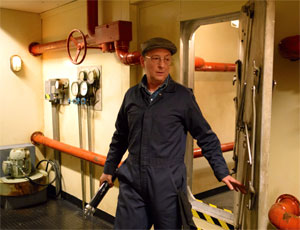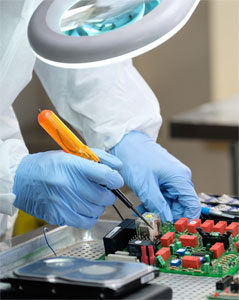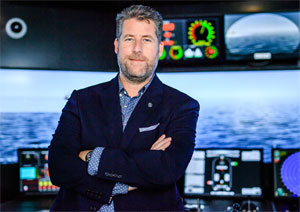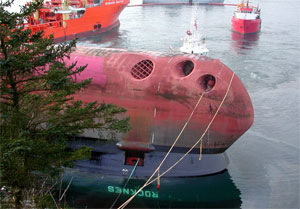For 12 seasons, American viewers have been engrossed by the Smithsonian Channel’s “Air Disasters” series, which combines dramatizations of actual aircraft mishaps with accounts of how investigators ultimately determined what went wrong — and how to prevent similar accidents.
In January, the channel premiered another series, “Disasters at Sea,” which takes a similar approach to analyzing maritime tragedies. Many of the initial shows have focused on casualties familiar to mariners.
“Trapped in Typhoon Alley,” the first episode in the series, tells the story of M/V Derbyshire, which was hit by Typhoon Orchid in 1980 while en route from Canada to Japan carrying nearly 160,000 tons of iron ore. The ship never made port, and no survivors were ever found. After a sister ship sank, the Seafarers Union supported a deepwater search for the Derbyshire wreck in 1994 off the coast of Japan. Investigators found that waves had damaged hatches and other structural components, leading to progressive flooding that eventually took down the vessel.
Other casualties that have become topics for the show include:
• SS Marine Electric, a bulk carrier that sank off the coast of Virginia during a storm in February 1983. Thirty-one of the 34 crewmembers died. The accident investigation uncovered serious maintenance flaws that led to more stringent inspections and the creation of the Coast Guard rescue swimmer program, which prepares responders to enter the water to help survivors unable to reach lifeboats or rafts.
• M/V Rocknes, a rock-discharge vessel that rapidly capsized off the coast of Norway in January 2004, leaving much of its crew trapped inside. Eighteen mariners died.
• The rescue of passengers from M/V Explorer, which hit an iceberg and sank during an Antarctic cruise in November 2007, stranding 154 people on inflatable lifeboats in subfreezing cold.
 |
|
Alaska Ranger engineer Rodney Lundy, portrayed in the Smithsonian Channel series by John Dickhout, shuts a door after discovering flooding in the rudder room. Five mariners died when the factory trawler sank off the Aleutian Islands in March 2008. |
|
Courtesy Smithsonian Channel |
• The sinking of Alaska Ranger in March 2008, which led to the largest cold-water rescue in U.S. Coast Guard history. Forty-two mariners survived, but five were killed.
• MSC Napoli, which began to break apart in the English Channel in January 2017, imperiling the crew and causing a navigational hazard.
“Disasters at Sea” was produced by Exploration Production Inc. (EPI) in association with Smithsonian Networks and the Discovery Channel (Canada). Kelly McKeown, one of the two executive producers for EPI, said the production company was originally an in-house entity at Discovery Canada and the show is a natural outgrowth of prior programming.
“The ocean does well with our audience. We have previously done ‘Mighty Ships’ and ‘Mighty Cruise Ships,’ and also the Discovery audience loves real working jobs and heroics and the stakes those people face,” she said.
Doing a maritime disaster series was always an idea on the back burner, but after finally looking further into the concept, it was an eye-opener.
“As we started to craft the format and content and looked at the stories, we couldn’t believe what we found, like the fact that three ships still go down every month on average,” McKeown said.
In other words, there’s a lot more to talk about than Titanic and Edmund Fitzgerald, ship stories that many Americans know.
 |
|
A salvage technician takes apart the computer hardware from M/V Rocknes in a scene from the Smithsonian series. “As we started to craft the format and content and looked at the stories, we couldn’t believe what we found, like the fact that three ships still go down every month on average,” says executive producer Kelly McKeown. |
|
Courtesy Smithsonian Channel |
“The ocean is a force of nature, no matter how big the ship is, so it just leads to very compelling stories,” McKeown said. She explained that the series focuses on the heroics and the people behind the events, including master mariners, as well as the investigators who try to find out what happened “when they sometimes have no evidence because it is at the bottom of the ocean.”
“With what they do, figuring out what went wrong in an effort to make sure it never happens again, they are heroes too,” McKeown said.
“Ships are old souls,” she added. “They might’ve started as one type of ship and then they’re modified and have different owners, so many of our experts are naval architects who help us track back the history.”
In addition to naval architects, McKeown said the show has been helped by a simulator at Memorial University in St. John’s, Newfoundland, that can help illustrate how to operate a ship in icy conditions. The studio also has a setup in Hamilton, Ontario, with a ship’s bridge mounted on gimbals in front of a “green screen,” so producers can re-create the vantage point of a crew in a storm.
McKeown said the series has come to rely heavily on Chris Hearn, a master mariner from Newfoundland. Hearn has logged 15 years at sea, from offshore operations to general cargo vessels and oil tankers to seismic surveying. He has sailed as master on ships nationally and internationally. He began his nautical career in 1994 after graduating from the Marine Institute of Memorial University. In 2009, Hearn returned to the university as director of the Center for Marine Simulation.
“He’s an expert on the marine technology, and he also helps us understand life at sea and the different jobs on the ship so we can get it right,” McKeown said.
Hearn is more modest about his role. He said he was originally consulted about some of the more pivotal maritime accidents that led to changes in regulations or design standards.
 |
|
Chris Hearn, shown in a simulator at Memorial University in Newfoundland, served as an expert and consultant for “Disasters at Sea.” He says that many viewers who are generally “sea-blind” will now realize “there are real people out there.” |
|
Courtesy Smithsonian Channel |
“I work with the writers and the producers and directors to help them understand the tech content,” he said. “They’re good people, but they don’t have the understanding and don’t know the tech jargon and the content. I do, so it usually has to be transcribed so they can understand what is most important and what was going on (on the ship). When they’re desperate, they put my mug on TV and I fill in, putting things in layman’s terms.”
Hearn said that people are generally “sea-blind,” and the series helps them focus on people in the industry and the incredible challenges they face. “It is an environment that’s not like any other. In some cases the people could overcome the challenges, but in others not,” he said.
“When things go wrong, they go very wrong. Ultimately, the show makes ships more than just an abstract idea for the audience,” he added.
Hearn said that many people who live near the coast or drive along the shoreline have no real idea about what goes on within sight on the water. “Now they will realize there are real people out there,” he said.
According to Hearn, the series is built around “a fairly global selection” of accidents from the Atlantic, Pacific and Antarctic. Is it dumbed down? “I don’t think so,” he said. “I’m hoping the audience will look on mariners with a sense of dignity.” What is being presented is a view of the operational challenges and difficult conditions under which mariners work, along with an explanation of why they train so hard, he said.
Michael O’Hearn, who has written extensively about the fishing industry and co-authored a children’s book explaining the maritime world — Hercules the Harbor Tug — has seen the Smithsonian programs and is impressed.
“They did a great job of capturing the interesting ‘people’ stories as well as helping the audience understand the challenges of keeping vessels safe,” he said.

